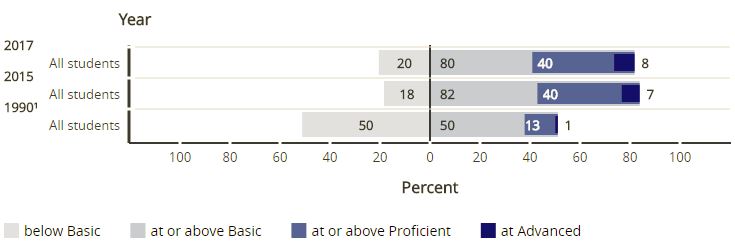The Daily Dish
April 17, 2018
Readin’, ‘Ritin’ and Robots
Eakinomics: Readin’, ‘Ritin’ and Robots
A cottage industry has developed around the future of the American workforce, with commissions, programs, initiatives, and other similarly named efforts springing up to assess the threat posed by artificial intelligence (AI), machine learning, and similar phenomena. Part and parcel of these efforts are attempts to identify new strategies for lifelong learning, work training, re-training, and other aspects of enhancing movement from one (presumably obsolete) job to another (not obsolete, good paying) job. (Full disclosure, AAF has participated in these efforts at the Aspen Institute and Markle Foundation.)
These problems, however, are nothing new. Thirty-five years ago this month saw the release of A Nation at Risk, a report of findings from a presidential commission established by President Reagan. This report warned of foreign economies catching up and surpassing the United States with regard to the commodity of an educated labor force – a threat similar to that from AI. The report highlighted the testimony of business and military leaders who complained that they were required to spend millions of dollars on costly remedial education and training programs in such basic skills as reading, writing, spelling, and computation. Without such remedial work, employees could not even begin, much less complete, the sophisticated training essential in much of the modern workforce. “These deficiencies come at a time when the demand for highly skilled workers in new fields is accelerating rapidly,” the report noted.
One unifying theme of these efforts and others should be: Make sure the education system works the first time. That is, everyone benefits if U.S. students learn more in school, prior to any need for rethinking their skills. Viewed from this perspective, the recently released results of the National Assessment of Education Progress (NAEP) are depressing. For all practical purposes the results were the same in 2017 as in 2015. In short, progress has stalled – and it has stalled at an unsatisfactory level of performance.
The most recent NAEP was administered in early 2017 to a nationally representative sample of 149,400 fourth graders and 144,900 eighth graders. Results are reported for reading and mathematics based upon what students should know and be able to do at their grade level. Results are reported as percentages of students performing at or above four achievement levels – Below Basic, Basic, Proficient, and Advanced. Students performing at or above the Proficient level on NAEP assessments demonstrate solid academic performance and competency over challenging subject matter.
AAF’s Chad Miller has a complete discussion. I will simply highlight of his two charts. The first shows that progress has stalled in recent years.
The second is even more daunting. Progress has stalled at a low level of achievement. Fully one-fifth of fourth graders are falling below basic proficiency in math, while the fraction is one-third for reading. In the eighth grade, the comparable “failure rates” are 30 percent and 24 percent. It is not a pretty picture and not one that should be acceptable.
Fourth Grade Math
Eighth Grade Math
Fourth Grade Reading
Eighth Grade Reading
There are vexing and complicated problems in college education, jobs-based skills, re-training, and a host of other labor-skills issues. But all are made easier by improving proficiency early in education.
Fact of the Day
The estimated aggregate time burden to complete the IRS forms, when rounded, is 8.1 billion hours.















